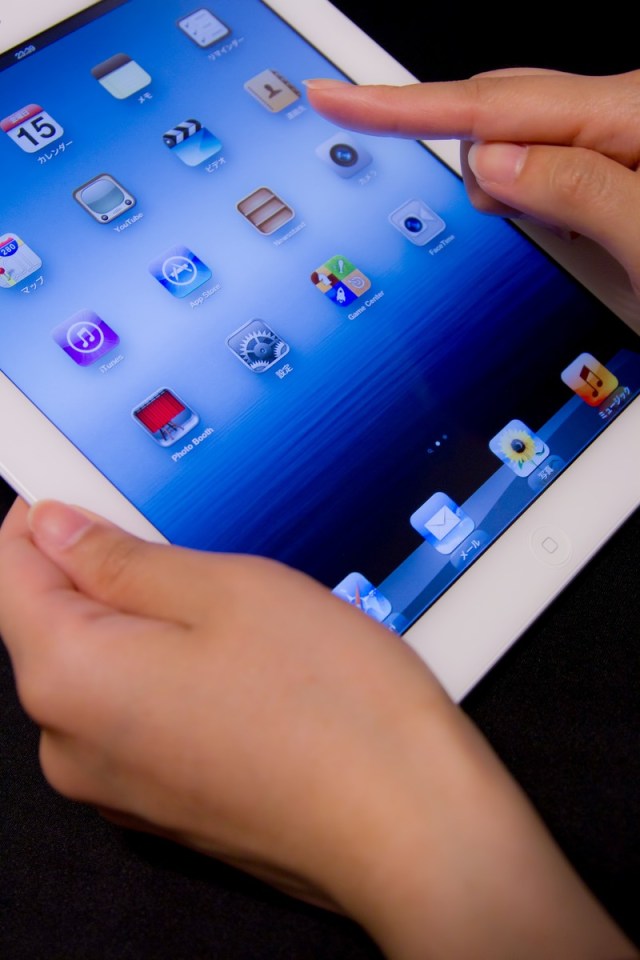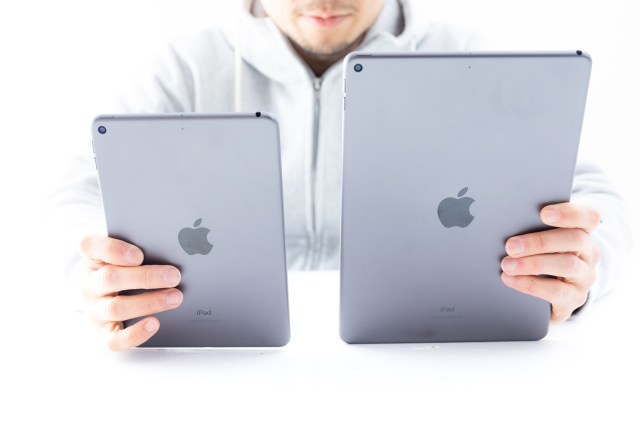
Kyoto’s mandate seems to be one of the most burdensome on families in light of national directives for equipping students with electronic devices.
Beginning with the 2022 academic year, the Kyoto Prefectural Board of Education will require students entering public prefecturally administered high schools to purchase electronic tablets, expected to cost somewhere in the range of 60,000-70,000 yen (US$550-640), and pay for them out of pocket. Because high school is not part of compulsory education in Japan, even at public schools tuition is charged, and families have begun to voice their frustration at the added financial burden.
“We feel nothing but anger. Who has the money for this after the economic impact of the coronavirus?” noted one parent in the reader’s column of Kyoto Shimbun. “My husband’s monthly salary is around 300,000 yen and my part-time job brings in another 50,000 yen,” another parent detailed. “We have two children and are paying for cram school as well. This added burden is causing deep stress. Just entering high school is already said to cost 200,000-300,000 yen for uniforms, textbooks, bags, and commuter passes alone. Why can’t they use tablets that we already own, or select ones that cost no more than 20,000 yen?”
▼ Other concerns voiced at an ad hoc committee meeting in March included ambiguity about families without Wi-Fi at home and unease that the policy would further highlight economic disparities among students.
In fact, there is currently a national directive in the works for every prefectural high school student to be equipped with an electronic device. Unlike with elementary and junior high school students, there is no national budgetary provision for such devices for high school students. Therefore, it is up to each local government as to whether to use public funds for the acquisition of devices or whether the bill is to be footed by families. According to a survey distributed by MEXT in January and February, 12 prefectures have so far indicated plans to pay for devices using public funds while 15 will require families to pay at their own expense.
In the 2021 academic year, five prefectural high schools in Kyoto have already implemented the tablet requirement as part of the first wave of schools. The following is the specific breakdown of expenses that was distributed to all matriculating students at these five schools:
1. 10.2-inch iPad (8th Generation) Wi-Fi 32GB: 34,760 yen
2. Keyboard and case: 9,790 yen
3. Applications and installation fees: 8,470 yen
4. Extended warranty (1 year): 4,400 yen
5. Tablet maintenance (1 year): 1,980 yen
6. Stylus pen: 8,690 yen
With strict instructions for families to purchase an 8th-generation iPad specifically, that brings the total financial burden per matriculating student to 68,090 yen.
▼ Also for consideration: the combined cost of the supplementary fees is almost as much as the cost of the tablet itself.
In contrast, the Hiroshima Prefectural Board of Education also enacted the requirement for all prefectural high schools this academic year with clear provisions for payment-free options for low-income households and have budgeted financial support for applications from 2,700 families. Similarly, the Tokyo Metropolitan Government Board of Education will begin requiring tablets for prefectural high school students in the 2022 academic year at families’ expense. However, in their case, the Board will present a variety of device models and leave the specific choice of model up to each school.
▼ “Which one should we make our students buy?”
So far the Kyoto Prefectural Board of Education has responded to widespread concerns by stating that they are currently developing their own system for low-income households to rent tablets or pay for them using interest-free loans. Their justifications for requiring students to provide their own tablets is that there are now more opportunities for high school students to study at home using tablets than ever before, they can accumulate their study notes on a single device over three years and continue to access them after graduation, and free applications can replace separate purchases (e.g., using free downloadable language software rather than purchasing a separate electronic dictionary). In addition, they have already observed hurdles for those students using tablets that they already own–including screen size issues, connectivity issues to Wi-Fi at school (forcing them to pay for additional Internet fees), and having issues installing applications on their own.
Hopefully the prefecture can reach equitable solutions to these potential problems in the near future, without taking too much of a one-size-fits-all approach.
Source: Kyoto Shimbun via Yahoo! Japan News via Hachima Kiko
Top image: Pakutaso
Insert images: Pakutaso (1, 2, 3)
● Want to hear about SoraNews24’s latest articles as soon as they’re published? Follow us on Facebook and Twitter!




 Tokyo makes high school free for all families, even the rich ones
Tokyo makes high school free for all families, even the rich ones Japanese university globalizes with fall start date, governor wants English as official language
Japanese university globalizes with fall start date, governor wants English as official language Failed your important entrance exams? That’s too bad–here’s a steak to make you feel better
Failed your important entrance exams? That’s too bad–here’s a steak to make you feel better Shibuya gives each public elementary and junior high student a Surface Go 2 tablet for school
Shibuya gives each public elementary and junior high student a Surface Go 2 tablet for school Japanese Komeito party suggests 20,000 yen (US$189) grant for graduating high school students
Japanese Komeito party suggests 20,000 yen (US$189) grant for graduating high school students Foreigner’s request for help in Tokyo makes us sad for the state of society
Foreigner’s request for help in Tokyo makes us sad for the state of society Japanese city loses residents’ personal data, which was on paper being transported on a windy day
Japanese city loses residents’ personal data, which was on paper being transported on a windy day Ghibli Park now selling “Grilled Frogs” from food cart in Valley of Witches
Ghibli Park now selling “Grilled Frogs” from food cart in Valley of Witches Historical figures get manga makeovers from artists of Spy x Family, My Hero Academia and more
Historical figures get manga makeovers from artists of Spy x Family, My Hero Academia and more Osaka governor suggests lowering voting age to 0 to curb population decline
Osaka governor suggests lowering voting age to 0 to curb population decline Should you add tartar sauce to Japanese curry rice? CoCo Ichi makes diners an unusual offer
Should you add tartar sauce to Japanese curry rice? CoCo Ichi makes diners an unusual offer Smash Bros. director Sakurai stabs Kirby in the face, has delicious justification for it
Smash Bros. director Sakurai stabs Kirby in the face, has delicious justification for it Haku is…Chihiro’s dead brother? Studio Ghibli fans blown away by Spirited Away theory
Haku is…Chihiro’s dead brother? Studio Ghibli fans blown away by Spirited Away theory Mt. Koya planning to instate visitor’s tax to cope with huge tourist numbers
Mt. Koya planning to instate visitor’s tax to cope with huge tourist numbers Japanese ramen restaurants under pressure from new yen banknotes
Japanese ramen restaurants under pressure from new yen banknotes McDonald’s new Happy Meals offer up cute and practical Sanrio lifestyle goods
McDonald’s new Happy Meals offer up cute and practical Sanrio lifestyle goods French Fries Bread in Tokyo’s Shibuya becomes a hit on social media
French Fries Bread in Tokyo’s Shibuya becomes a hit on social media Studio Ghibli releases new action figures featuring Nausicaä of the Valley of the Wind characters
Studio Ghibli releases new action figures featuring Nausicaä of the Valley of the Wind characters New private rooms on Tokaido Shinkansen change the way we travel from Tokyo to Kyoto
New private rooms on Tokaido Shinkansen change the way we travel from Tokyo to Kyoto Red light district sushi restaurant in Tokyo shows us just how wrong we were about it
Red light district sushi restaurant in Tokyo shows us just how wrong we were about it Tokyo Tsukiji fish market site to be redeveloped with 50,000-seat stadium, hotel, shopping center
Tokyo Tsukiji fish market site to be redeveloped with 50,000-seat stadium, hotel, shopping center All-you-can-drink Starbucks and amazing views part of Tokyo’s new 170 meter-high sky lounge
All-you-can-drink Starbucks and amazing views part of Tokyo’s new 170 meter-high sky lounge Beautiful Ghibli sealing wax kits let you create accessories and elegant letter decorations【Pics】
Beautiful Ghibli sealing wax kits let you create accessories and elegant letter decorations【Pics】 Studio Ghibli releases Kiki’s Delivery Service chocolate cake pouches in Japan
Studio Ghibli releases Kiki’s Delivery Service chocolate cake pouches in Japan New definition of “Japanese whiskey” goes into effect to prevent fakes from fooling overseas buyers
New definition of “Japanese whiskey” goes into effect to prevent fakes from fooling overseas buyers Our Japanese reporter visits Costco in the U.S., finds super American and very Japanese things
Our Japanese reporter visits Costco in the U.S., finds super American and very Japanese things Studio Ghibli unveils Mother’s Day gift set that captures the love in My Neighbour Totoro
Studio Ghibli unveils Mother’s Day gift set that captures the love in My Neighbour Totoro More foreign tourists than ever before in history visited Japan last month
More foreign tourists than ever before in history visited Japan last month New Pokémon cakes let you eat your way through Pikachu and all the Eevee evolutions
New Pokémon cakes let you eat your way through Pikachu and all the Eevee evolutions Sales of Japan’s most convenient train ticket/shopping payment cards suspended indefinitely
Sales of Japan’s most convenient train ticket/shopping payment cards suspended indefinitely Sold-out Studio Ghibli desktop humidifiers are back so Totoro can help you through the dry season
Sold-out Studio Ghibli desktop humidifiers are back so Totoro can help you through the dry season Japanese government to make first change to romanization spelling rules since the 1950s
Japanese government to make first change to romanization spelling rules since the 1950s Ghibli founders Toshio Suzuki and Hayao Miyazaki contribute to Japanese whisky Totoro label design
Ghibli founders Toshio Suzuki and Hayao Miyazaki contribute to Japanese whisky Totoro label design Doraemon found buried at sea as scene from 1993 anime becomes real life【Photos】
Doraemon found buried at sea as scene from 1993 anime becomes real life【Photos】 Tokyo’s most famous Starbucks is closed
Tokyo’s most famous Starbucks is closed One Piece characters’ nationalities revealed, but fans have mixed opinions
One Piece characters’ nationalities revealed, but fans have mixed opinions We asked a Uniqlo employee what four things we should buy and their suggestions didn’t disappoint
We asked a Uniqlo employee what four things we should buy and their suggestions didn’t disappoint Princesses, fruits, and blacksmiths: Study reveals the 30 most unusual family names in Japan
Princesses, fruits, and blacksmiths: Study reveals the 30 most unusual family names in Japan Tokyo public schools will stop forcing students with non-black hair to dye it, official promises
Tokyo public schools will stop forcing students with non-black hair to dye it, official promises Japanese high schools stop asking students to specify their gender on application forms
Japanese high schools stop asking students to specify their gender on application forms Snappy as they look, Japanese school uniforms can be an extremely expensive hassle for parents
Snappy as they look, Japanese school uniforms can be an extremely expensive hassle for parents Japanese teacher beats up student for making fun of his body by calling him anime character name
Japanese teacher beats up student for making fun of his body by calling him anime character name The top 10 universities in Japan determined by 2021 World University Rankings
The top 10 universities in Japan determined by 2021 World University Rankings Famed educator says Steve Jobs, Bill Gates would have been ruined by Japanese education system
Famed educator says Steve Jobs, Bill Gates would have been ruined by Japanese education system Tokyo Tama schools distributing free feminine hygiene products to students
Tokyo Tama schools distributing free feminine hygiene products to students Top five Japanese prefectures for childhood education expenditure would make any wallet shudder
Top five Japanese prefectures for childhood education expenditure would make any wallet shudder Majority of Nagasaki high schools and middle schools have white-underwear-only rules, study finds
Majority of Nagasaki high schools and middle schools have white-underwear-only rules, study finds Japan’s most famous anime/manga artist trade school now has a fully online program
Japan’s most famous anime/manga artist trade school now has a fully online program Japanese supermarket’s funeral ad sparks controversy, debate over “blasphemy”
Japanese supermarket’s funeral ad sparks controversy, debate over “blasphemy” Japanese schools are losing their pools due to rising maintenance costs and aging facilities
Japanese schools are losing their pools due to rising maintenance costs and aging facilities Japanese junior high school student comes up with ingenious way to bypass iPad usage restriction
Japanese junior high school student comes up with ingenious way to bypass iPad usage restriction Public schools in Japan’s Saga Prefecture will no longer regulate/check students’ underwear color
Public schools in Japan’s Saga Prefecture will no longer regulate/check students’ underwear color
Leave a Reply